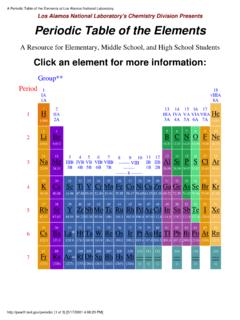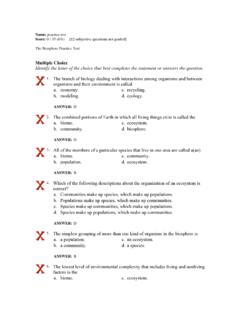Transcription of ORGANIC CANNABIS GROWERS GUIDE - Dr Earth
1 ORGANICCANNABISGROWERS GUIDEAn easy to follow schedule that takes all of the guesswork out of what to do and when to do it. This schedule is designed to grow and feed one plant in a 5 gallon size container. If you are growing more, simply multiply by whatever amount you are growing. The basic schedule provides everything your plants need to thrive, but if you want to try a more intense feeding regimen, we have also included an advanced schedule to add additional nutrients to your grow cycle. Basic Feeding ScheduleGROWTH STAGEEARLY BLOOM STAGELATE BLOOM STAGEFLUSHING STAGE14 Week Cycle1234567891011121314 Nitro Big 3-0-1 (Grow)2 oz. Pot Of Gold 1-1-1 (Anytime)1 oz. Golden Bloom 1-2-1 (Bloom)1 Feeding Schedule Root Gold 0-2-11 oz.
2 Metabolic Transformer* 2 cups*2 cups*2 cups*2 cups*2 cups* Home Grown 4-6-3** Cup Cup* Metabolic Transformer is to be mixed at a rate of 2 tablespoons per gallon of pure water then applied at the rate of 2 cups per individual plant or more as they grow. ** The Home Grown cup rate is based on a 5 gallon container. Adjust the amount you apply if you are using a smaller or larger size container. 2 The ratios on the liquids are per gallon of water. The amount of gallons for each plant will vary depending on container size and number of plants, so mix accordingly. Make sure when watering with or with out nutrients to not over water to prevent valuable nutrients from draining out of the pot. Allow approximately 50-75 days to cultivate ORGANIC CANNABIS for notes:This Feeding Chart is for weekly applications and may require additional waterings in the same week.
3 GROW STAGE - WEEKS 1-4 Run lights for 18 hours to 24 hours a day. Follow Feeding Schedule. EARLY BLOOM - WEEKS 5-8 Set light timer to 12 hours of light & 12 hours of no light. Follow Schedule. L AT E BLOOM - WEEKS 9-14 Continue 12 hour light, 12 hour no light cycle. Follow Schedule. Duration of cycle may need to be adjusted based on environment & strain of FERTILIZER INDOOR FEEDING SCHEDULE product lineup:BASIC FEEDING SCHEDULE PRODUCTS (All you need to grow healthy, productive plants) Nitro Big High Nitrogen Liquid Plant Food 3-0-1 Pot Of Gold All Purpose Liquid Plant Food 1-1-1 Golden Bloom High Phosphate Plant Food 1-2-1 ADVANCED FEEDING SCHEDULE PRODUCTS (To take your feeding schedule up a notch) Root Gold Root Care Plant Food 0-2-1 Metabolic Transformer Soil Catalyst Home Grown Tomato, Vegetable & Herb FertilizerADVANCED GROWERSLIQUIDPROGRAMC lick on any product in the schedule below to view details.
4 * Pot of Gold 1-1-1 Liquid is to be mixed with water first (see product directions) then applied at the rate of 2 cups per individual plant or more as they grow.** Metabolic Transformer is to be mixed at a rate of 2 tablespoons per gallon of pure water then applied at the rate of 2 cups per individual plant or more as they basic feeding schedule cup rate is based on a 5 gallon container. Adjust measurement if you are using a different size container. Make sure when watering with or without nutrients to not over water, causing water to drain from the pots resulting in valuable nutrients draining out. Allow approximately 50-75 days to cultivate ORGANIC CANNABIS for notes:This Feeding Chart is for weekly applications and may require additional waterings in the same week.
5 GROW STAGE - WEEKS 1-4 Run lights for 18 hours to 24 hours a day. Follow Feeding Schedule. EARLY BLOOM - WEEKS 5-8 Set light timer to 12 hours of light & 12 hours of no light. Follow Schedule. L AT E BLOOM - WEEKS 9-14 Continue 12 hour light, 12 hour no light cycle. Follow Schedule. Duration of cycle may need to be adjusted based on environment & strain of lineup:BASIC FEEDING SCHEDULE PRODUCTS (All you need to grow healthy, productive plants) Home Grown Tomato, Vegetable & Herb Fertilizer Premium Gold All Purpose Fertilizer 4-4-4 Flower Girl Bud & Bloom Booster 3-9-4 ADVANCED FEEDING SCHEDULE PRODUCTS (To take your feeding schedule up a notch) Pot of Gold All Purpose Plant Food 1-1-1 Metabolic Transformer Soil CatalystADVANCED GROWERSDRYFERTILIZERPROGRAMDRY FERTILIZER INDOOR FEEDING SCHEDULEB asic Feeding ScheduleGROWTH STAGEEARLY BLOOM STAGELATE BLOOM STAGEFLUSHING STAGE14 Week Cycle1234567891011121314 Home Grown Dry 4-6-3 (Grow) Cup Cup Premium Gold Dry 4-4-4 (Anytime) Cup Cup Flower Girl Dry 3-9-4 (Bloom)
6 Cup CupAdvanced Feeding Schedule Pot Of Gold Liquid 1-1-1*2 cups*2 cups*2 cups*2 cups*2 cups*2 cups* Metabolic Transformer**2 cups*2 cups*2 cups*2 cups*2 cups*Click on any product in the schedule below to view NUTRIENTSSECONDARY NUTRIENTSThe primary nutrients, required in the largest amounts, are nitrogen, phosphorus and potassium (referred to by the chemical shorthand N-P-K). Many of these nutrients may never make it to your plants if the pH is out of secondary nutrients are calcium, magnesium and sulphur. Most crops need these three secondary nutrients in lesser amounts than the primary nutrients. People are giving them more prominence in crop fertilization programs as they learn that N-P-K fertilizers alone cannot fulfill plant requirements.
7 Needed to produce amino Essential for plant cell division, vital for plant growth, directly involved in photosynthesis, necessary component of vitamins, aids in production and use of carbohydrates and affects energy reactions in the plant. Helps trap energy from sunlight. DEFICIENCY: causes thin stems, yellow leaves, slowed growth and yellowing where plants should be green. Helps regulate access to plant cells. Used for continuous cell division and formation. Involved in nitrogen metabolism. Required for enzyme activation and cell reproduction. Reduces plant respiration, aids translocation of Increases fruit set and stimulates microbial activity. DEFICIENCY: halts growing tips, curls leaves, and causes cell membranes to disintegrate, producing thin cell walls and blossom end for genetic material, cell membranes, root development, seed number and size.
8 Facilitates the use of energy, involved in photosynthesis, respiration, energy storage and transfer, cell division and enlargement. Promotes early root formation. Improves quality of fruits, vegetables and grains. DEFICIENCY: causes purple leaves beginning underneath, halted roots, slow growth, poor fruit and vegetable for the chlorophyll molecules that put the green in plants. Also used for enzyme activation. Improves utilization and mobility of phosphorus. Increases iron utilization in plants and influences earliness and uniformity of maturity. DEFICIENCY: causes yellowing of lower leaves and, in some cases, lower crop for carbohydrate metabolism. Influences the uptake of calcium, sodium and nitrogen.
9 Increases photosynthesis. Essential to protein synthesis. Important in fruit formation. Activates enzymes and controls their reaction rates. Improves quality of seeds and fruit, improves winter hardiness, increases disease resistance. DEFICIENCY: leads to flabby stems, halted growth, burnt leaf edges and vulnerability to disease. An integral part of amino acids needed to build proteins. Contributes to the development of several enzymes and vitamins. Aids in seed production and promotes nodule formation on legumes. Needed in chlorophyll formation. DEFICIENCY: causes younger leaves to yellow. NITROGEN (N)CALCIUM (Ca)PHOSPHORUS (P)MAGNESIUM (Mg)POTASSIUM (K)SULPHUR (S)Sixteen basic nutrients are required for crop development (plus hundreds more we know are needed in minute amounts).
10 Conventional agriculture tells us that 16 basic nutrients are all that is needed for plant is best to use well-rounded ORGANIC fertilizers and soil amendments for healthy plants and soil on a regular basis. You never know how much of any one nutrient is needed at a certain time of year, or time of day, for that matter. For example, nitrogen requirements can vary hourly depending on the time of day, soil temperature or the amount of photosynthesis a leaf is producing at the height of the solar ORGANIC materials are great sources of nutrients and are a safe way to ensure that all nutrients are available anytime a plant needs them. We favor ocean-based fertilizers, because they are loaded with nutrients, well beyond the basic sixteen needed for crop development.





